Melissa Hyde
“Why am I Mr. Pink?”
— Reservoir Dogs (1992)
Pink was a color so fashionable and beloved in the eighteenth century—in painting, dress, decorative arts, and even literature—that it has been said to have been invented by that century.[1] In France, it was the color par excellence of Rococo art. Like the Rococo itself, the color was closely identified with Madame de Pompadour. François Boucher’s Portrait of Pompadour at her Toilette (1758), for example, an homage to the intersecting cosmetic and painterly arts practiced by the Marquise and her favorite painter, glories in pink (Fig. 1).[2] Critics of the time commented peevishly on what they saw as an abuse of pink (which they likened to seductive cosmetics) in many of Boucher’s paintings, not least of all his famous Setting and Rising of the Sun (1753, The Wallace Collection), also painted for Pompadour.
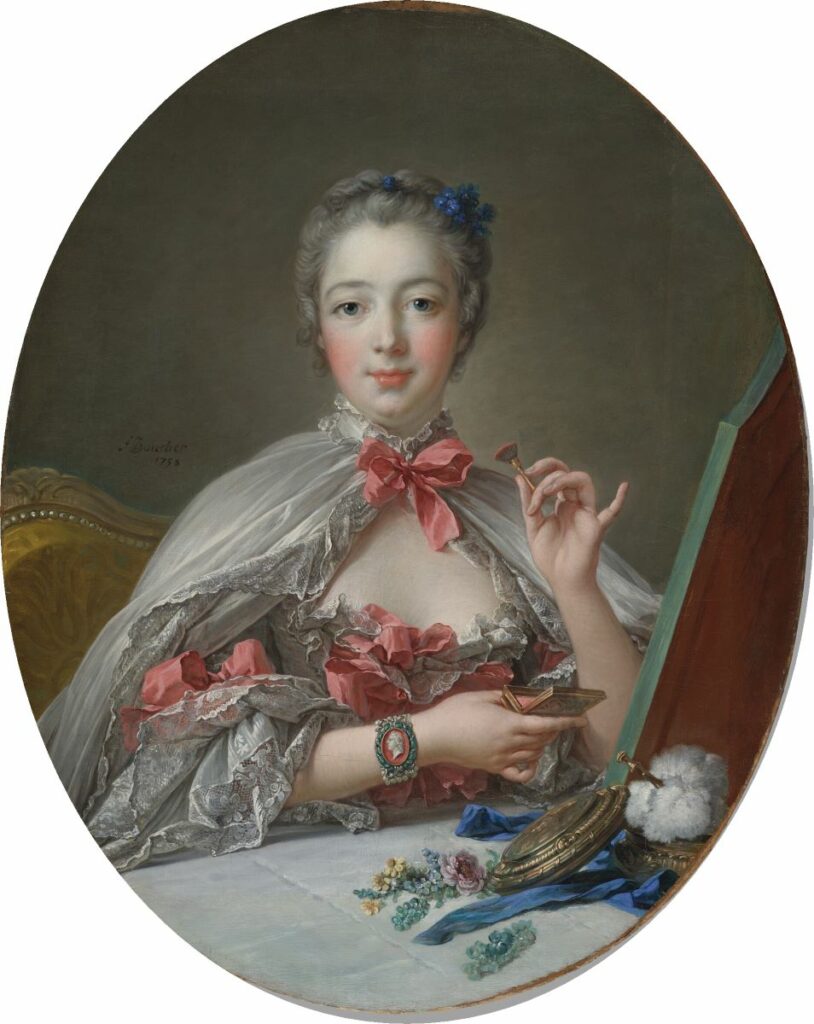
Some twenty years ago, I wrote about the Wallace paintings, and Pompadour at her Toilette in the context of critical discourses, as well as social and artistic practices, in which pink was intimately associated with cosmetic artifices embraced by women and “effeminate” men (sometimes identified by critics as petits-maîtres).[3] In part, the present essay represents a return to some of my earlier ideas. But here I mean to shift my focus from the domain of the feminine to constructions of masculinity in Rococo painting and eighteenth-century culture more broadly. This first line of inquiry is occasioned by my long-standing interest in how eighteenth-century French cultural discourses about “la couleur de rose” (as feminine, “aristocratic,” and Rococo) might affect our understanding of the many images of men in pink that range from the Regency to the Revolution. An important point of reference for that discussion will be the petit-maître, a polyvalent figure whose controversial status, in one way or another, inflects a great many eighteenth-century French portrayals of adult males wearing the color.
Secondly, inspired by art historical scholarship that has demonstrated the foundational importance of issues of race for the early modern period, I take this opportunity to look anew at pink and its meanings in light of recent work on French art, which has been slower to bring post-colonial studies to bear on the field than scholarship on Latin American or British art and empire.[4] Prompted especially by Oliver Wunsch’s thought-provoking essay “Making Up Race: Whiteness, Pinkness, and Pompadour,” my own essay builds on its consideration of pink in relation to constructions of race. Sharing Wunsch’s premise that “just as a portrait of a solitary man can say something about masculinity, a portrait of a white person alone can deliver a message about race,” I will give special attention to one particular portrait of a man en rose, though I will also touch on other images in which pink is a central thematic and chromatic concern.[5] Of the vast array of eighteenth-century French examples from which to choose, Jean-Baptiste Perronneau’s Portrait of Olivier Journu of 1756 is the one that perhaps better than any other brings together my central themes (Fig. 2).
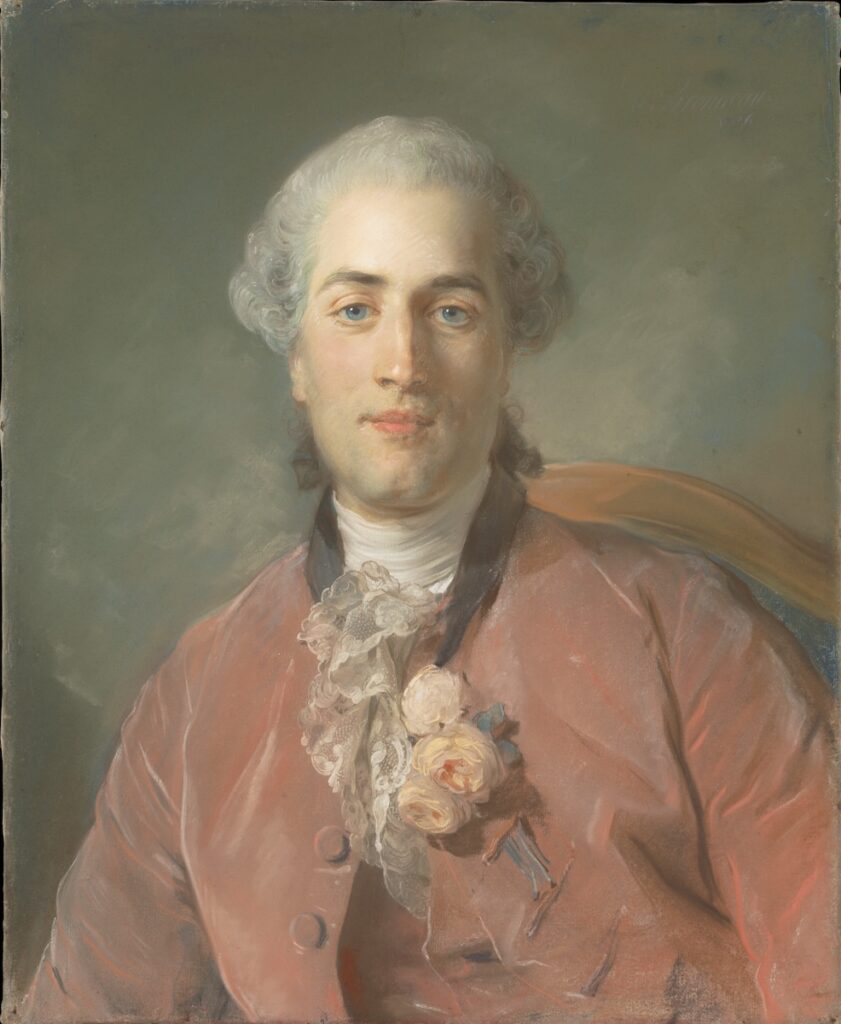
Olivier Journu was an elder son in a wealthy, prolific, and socially ambitious Bordelais family, many of whom sat for the artist between 1756-69—including at least three of his brothers, also wearing pink.[6] However, it is the portrait of the fashionably elegant Olivier, with his limpid aquamarine eyes, square jaw, and sensual mouth, that has long captivated viewers. As the authors of the first catalogue of Perronneau’s oeuvre put it in 1909, this “delicious portrait . . . has troubled many hearts and charmed every eye with its harmonies of pink and green.”[7] An element of special interest for present purposes, besides the harmonies of pink in which Journu’s suit of sumptuous velvety pink plays a starring role, is the unusual boutonnière (almost a corsage) of three roses jauntily tucked into the button hole of his coat. This detail gave the portrait its name in the nineteenth century, when, the identity of the sitter having been lost, the picture was known under the title L’homme à la rose. As we’ll see, this flower had close etymological ties to the color pink, to “flesh” tones, and to the feminine, adding further layers of possible meanings to this fascinating portrait of a man in pink.
In what follows, my interests are twofold. I want to think about how gender, class, race, and the color pink can be understood to intersect in this pastel portrait, but also to ask: what can Perronneau’s portrait tell us about what it meant for a racially “white” man to wear a color that was increasingly being defined as feminine, or to have himself depicted wearing it? My approach to these questions takes into account cultural, historical, and geographical contexts of the portrait’s making, as well as some of its material and iconographical aspects and the identity of the sitter. My arguments admittedly are speculative. I offer them as a provocation: to consider, on the one hand, how pink opened up modalities of masculinity (both to cis-gendered and queer men) that were antagonistic to Enlightenment ideals of manliness;[8] and to explore, on the other hand, how pink and pink skin could function in portraiture as the generic color of racial “whiteness,” at the very historical moment when—to paraphrase Anne Lafont—modern conceptions of race were emerging that placed whiteness and so-called white skin at the top of the human hierarchy.[9]
A Rose by Any Other Name? or, Fifty Shades of Pink
In France, it was only during the second half of the century that pink (rose) began to be used regularly as a noun (le rose) or adjective (rose), rather than the word for the flower (la rose). However, the French were “thinking pink” before that. The expression “couleur de rose” often appears in texts related to art and the natural sciences and in literature.[10]
Like other colors whose names are tied to specific materials or objects, rose derives from the flower of that name, rosa in Latin.[11] While roses came in many colors (reds, whites, yellows) in the eighteenth century, “ordinary” (cultivated) roses were not “strong reds” but “pale roses” (which I interpret to mean a pale red or pink).[12] One cultivar that was ubiquitous in paintings was the Rosa x centifolia, also known as the Provence or cabbage rose, or sometimes by names that refer to its color: “Rosa incarnata” or Rosa Alba (the pink-white rose). Though the centifolia rose had been widely depicted in floral still lives since the late sixteenth century—since the beginning of still life painting, essentially—it was the signature flower of Rococo painting and embraced as a personal emblem by Pompadour, among others. As one can see in the work of Boucher, who made a specialty of painting these roses, they typically appeared in shades of pink ranging from a delicate pale shell pink (inclining towards peachy tones), to a deep rose-pink that verges on red.
Mark Ledbury has recently argued that for Boucher the natural world—not only flowers, but also shells—were the source of inspiration for the many varieties of pink to be found in his work.[13] Noting how prominently rose and couleur de rose figure as descriptors in French publications on botany and especially in conchologies of the period, Ledbury observes that avid shell collecting—conchophilia—vastly expanded the repertoire of “pinkness,” as colonial trading made new specimens available and scientific publications described their properties in meticulous detail. A catalogue of shells at auction in 1756 contains over thirty references to different shades of pink. As Ledbury points out, the very terms that were invented to describe these wondrous pink objects were made possible by colonialism.[14]
Thinking Pink: The New White
Whatever chromatic uncertainties attend the range of pinks signified by the terms couleur de rose/rose, semantically, pink as a color was related to terms for flesh tones (i.e., couleur de chair/flesh color and carnation or complexion). Carnation and its cognates, incarnat/e, incarnadine, all derived from the Latin incarnatum, “which signifies flesh color,” as a Latin-French dictionary of the time states.[15] Indeed, according to Michel Pastoureau, incarnat was the word for pink until it was given the name of rose in the eighteenth century.[16] In Antoine-Joseph Dezallier d’Argenville’s famous La Chonchyliologie, “flesh color” was the point of reference for the description of a pink shell, as “une belle Couleur de Rose ou incarnate” (translated in an English edition of 1771 as “a fine agreeable Rose or Flesh Colour”).[17]
No matter what variation of pink was comprehended by “flesh color,” la couleur de chair referred to the flesh of “white” people. By being thus conceptually related to white skin and “the” color of human flesh, eighteenth-century pinks were intimately related to the construction of whiteness as the “‘unraced’ norm,” as Richard Dyer put it twenty-five years ago.[18]
It is well established that a white skin tone was central to European ideals of female beauty and the representation of it.[19] As Antoine Le Camus’s famous Abdeker; or, the Art of Beauty of 1754 noted, “We reckon a white skin whose surface is spread over with the color of roses, to be the most perfect and the most agreeable with regards to its color.”[20] Pierre Mignard’s Portrait of Louise de Kéroualle, Duchess of Portsmouth with an Unknown Female Attendant (1682), now in the collection of London’s National Portrait Gallery, has been much cited as a key example of a type of portraiture in which the marmoreal whiteness of a female sitter’s skin is contrasted with the dark skin of her African attendant, in order to present white as the superior value.[21] This ideal whiteness was also particularly allied with pink, as can be seen in Boucher’s Portrait of Pompadour at her Toilette, which so declaratively presents pink (and white) skin as a matter of performative artifice and of the performance of whiteness, even in the absence of a Black attendant. The Portrait of Pompadour at her Toilette enshrines pink skin as central to an ideal of whiteness, or, perhaps more accurately, enshrines ideal femininity as whiteness. “White skin, whether natural or artificially obtained had a social value,” and also a racial value, as Lafont has pointed out.[22]
Engendering Pink
Time and again pink roses were likened to the blush (whether natural or cosmetically enhanced) on the cheeks of the ideal white woman. In literature, as well as the visual arts, rose symbolism associated with women had a long and rich tradition that went beyond complexion based metaphors. The flower was frequently imbued with contradictory meanings in relation to female sexuality and anatomy. It was the emblem of Venus, goddess of love and sexuality. But it was also the flower of virgins—“plucked roses” being a metaphor for lost virginity or “deflowering.” Images such as Boucher’s Awakening of Venus (Fig. 3), or Gabriel de Saint-Aubin’s Comparison of the Rose-Bud (1780), are examples of those in which a rose specifically symbolizes female anatomy, whether genitals or breasts.[23] Shells, another ubiquitous and pink motif in Rococo art, were also identified with the vagina, referred to euphemistically as coquillage or coquille in erotic literature.[24] These examples attest to the extreme to which roses, shells, pink, and the “feminine” intersected.
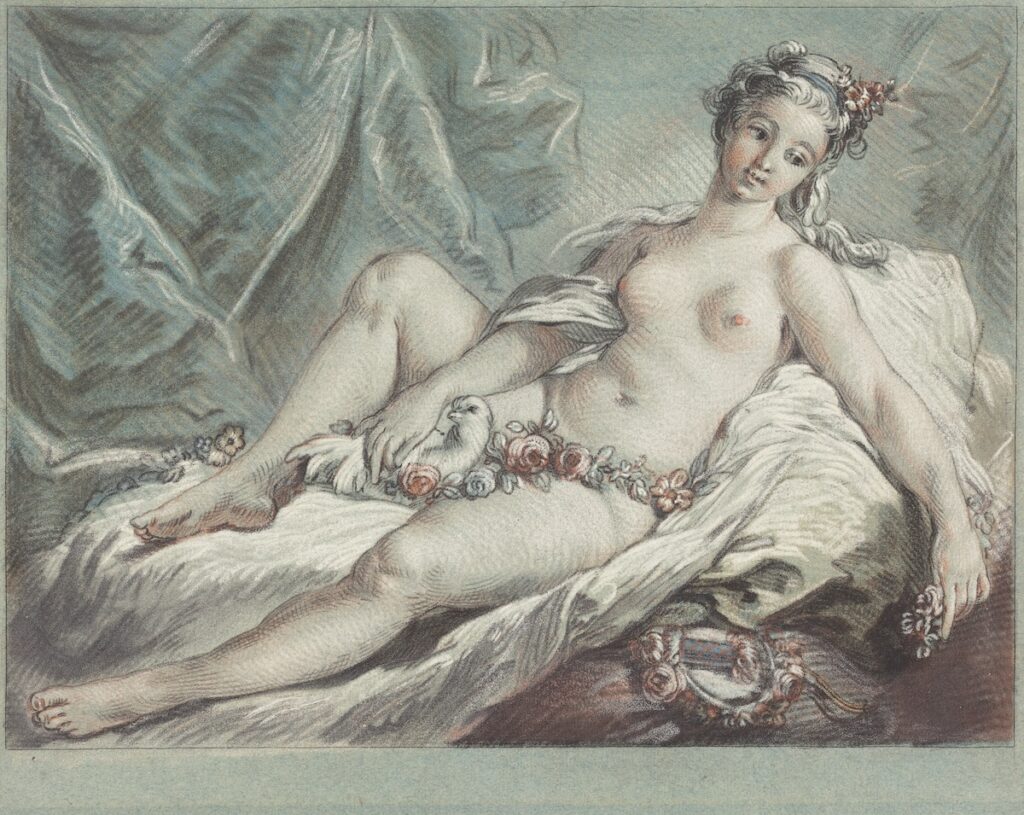
The association between femininity and pink was also a marked feature of art criticism during the second half of the eighteenth century. As I noted at the start, Boucher was taken to task for the overall pink tonalities in many of his paintings, or for his figures “de couleur rose.”[25] In his Salon of 1765, Denis Diderot famously declared that Boucher’s work reminded him too much of productions of the toilette table and insisted that Boucher’s art only appealed to the bad taste of petits-maîtres of both sexes. The philosophe was far from the only critic to blame Boucher’s success on women and men of fashion, or to identify pink with the petit-maître and a society that “wanted everything the color of roses.”[26] In this way, anti-rococo critics helped to construct pink as feminine/effeminate, inflecting it with specific connotations of gender and class.
Like Rococo art itself, pink could also be understood to contest certain Enlightenment ideals of gender. When worn (or otherwise embraced) by men, pink made men too much like women in their appearance and tastes. As such, it was intimately aligned with the challenges presented by elite manners and appearance to the idea promoted by many Enlightenment thinkers that men and women were “opposite” sexes.
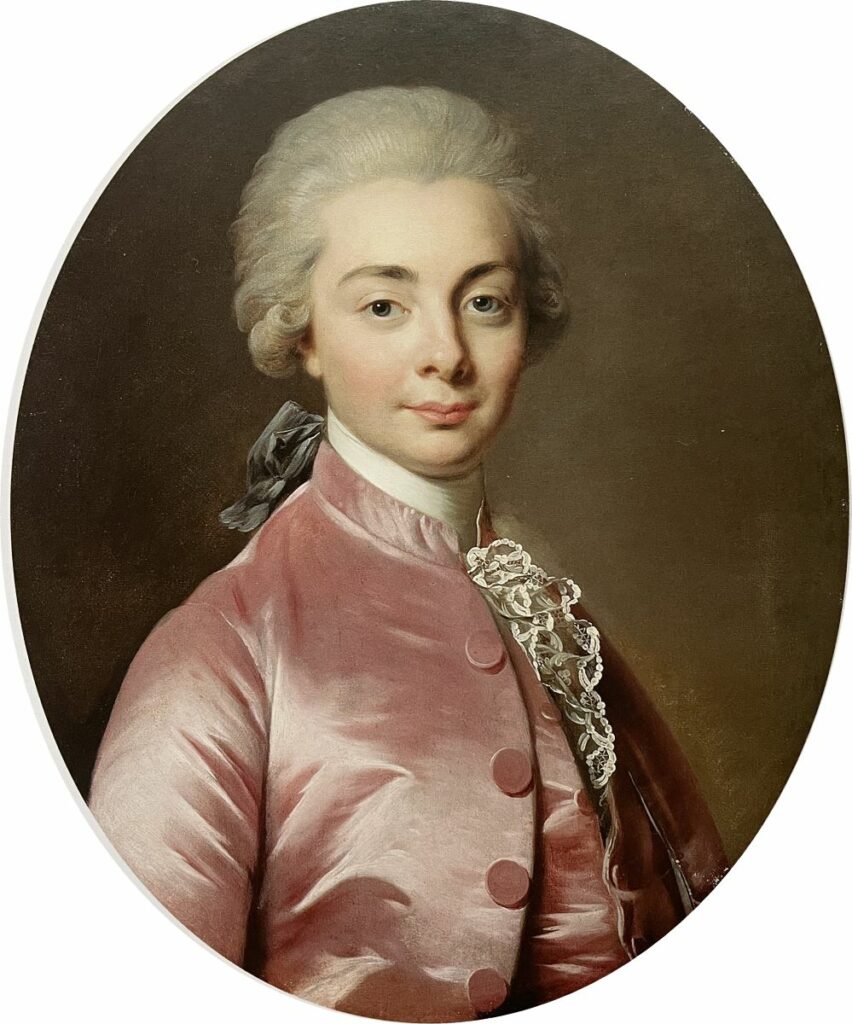
I suggest that we might understand Journu’s portrait—the sensuous pink lips, the deliberately elegant, even seductive languor, the large boutonnière of roses—as subverting or resisting conventional gender binaries. What is more, the pale rose complexions of men in portraits such as that of Olivier Journu, or Alexander Roslin’s later Portrait of a Young Man (c. 1780), indicate that in representation, if not in actual practice, pink skin, like pink attire, were not exclusively the province of women (Figs. 2 and 4).[27] Just how closely men and women might resemble one another in dress and affect is attested by Roslin’s portraits of two unidentified sitters wearing pink (Figs. 4 and 5).
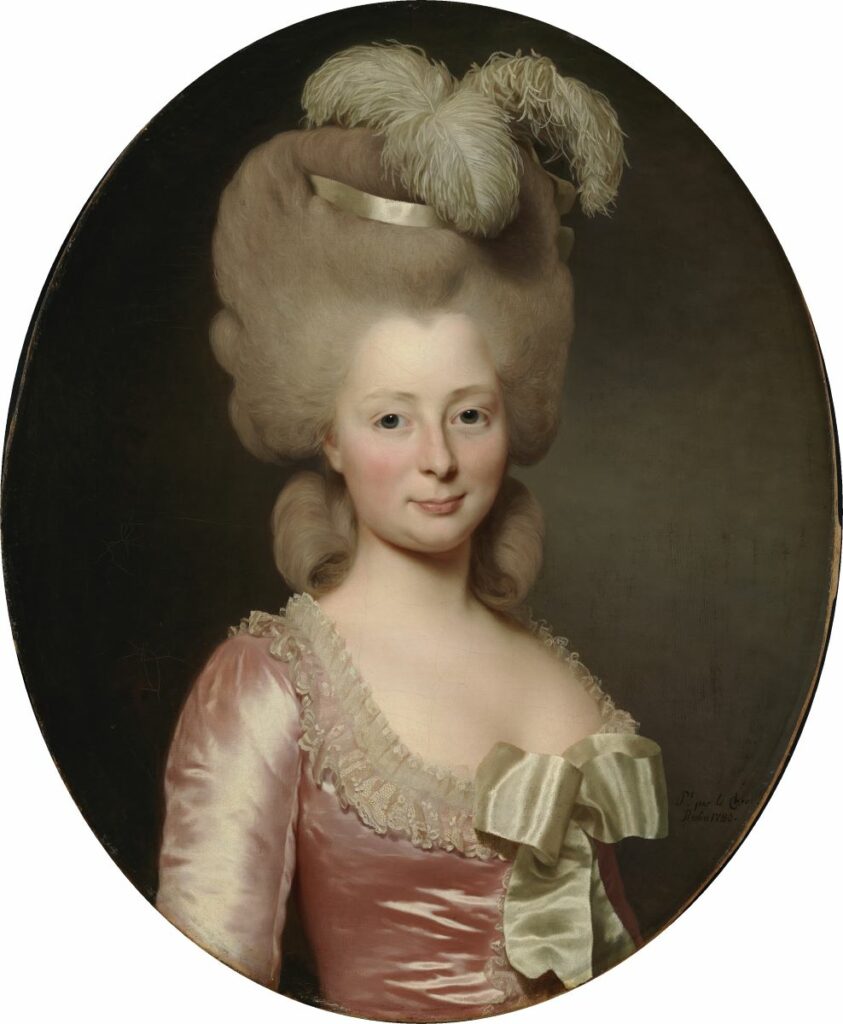
Its meanings as slippery and topsy-turvy as the whorls and concavities of a Queen Conch shell, pink had the power to subvert gender norms.[28] In resisting binary notions of gender, pink could also be seen as a sign of social disorder—even as it helped to reinforce or define racial norms in terms of (skin) color. Given the various powers of pink, the ubiquity of the association between femininity and pink makes the depiction of men in pink all the more noteworthy.
The Petit-Maître: Pretty in Pink
In 1908 Perronneau’s portrait of Journu was exhibited at the landmark exhibition, Cent Pastels. The catalogue entry cited an eighteenth-century poem by a countess reflecting on the seductive charms of a “petit maître poli,” as a perfect verbal portrait of L’homme à la rose.[29] Perronneau’s image of Journu does fit with many aspects of the type, which was so often negatively stereotyped by critics, especially during the second half of the eighteenth century. As we will see, this term, which was sometimes used as an insult, could also be a model of social refinement. Just as pink could have multiple, sometimes conflicting meanings depending on one’s point of view, so too could the category of the petit-maître.
The petit-maître was already a figure in the cultural landscape of the late seventeenth century, though exactly what the term referred to changed over time, as explained by an entry in the Encyclopédie from 1765: “This word is used to describe young men who seek to distinguish themselves by fashionable foibles. Those of the beginning of this century were libertines; those who followed them wanted to appear as men of good fortune.”[30]
This mid-century version of the petit-maître corresponded to the macaroni in England, who emerged with the conclusion of the Seven Years’ War (1756-63). Recently the subject of an indispensable study by Peter McNeil, “pretty gentlemen” and their fashions offer useful insights about the “jolis hommes” in France, who were a source of inspiration to their English counterparts.[31] Like the macaroni, the lavish sartorial display of the petits-maîtres was intended to express status, success, and cosmopolitan refinement. They similarly complicated notions of national character, masculinity, and sexuality.[32] In their desire to “appear as men of good fortune,” petits-maîtres were (like the macaroni) not an exclusively elite phenomenon, or even confined to a specific class. The petit-maître who is featured in Jean-Michel Moreau le Jeune’s Troisième suite for the Monument du Costume (1783) is explicitly a courtier, but already by the early eighteenth century, the phenomenon had spread “in the city to the simple bourgeoisie.”[33]
McNeil’s account of the macaroni suggests that their dress and appearance were more clearly codified than those of the petit-maître, though many distinctive macaroni fashions were inspired by French examples. The cut and colors of their suits were based on the habit à la française, with pink and green as a favorite color combination. Other macaroni fashions that were first taken up by the petit-maître included a black bagwig tied with a bow, the black ribbon coming from the bag and tucked in front en solitaire, a small tricorn hat never worn but carried, a decorative sword, and red-heeled shoes. Less common in France was the macaroni liking for large floral corsages or nosegays and the high toupet style wig.[34] The “fashionable foibles” of the petit-maître, then, included a passion for finery and the toilette that was traditionally considered the domain of women, and a liking for pink. These shared affinities with women is one reason the petit-maître (like the macaroni) was so often labeled an “être effeminé” by his critics, of which there were many.[35]
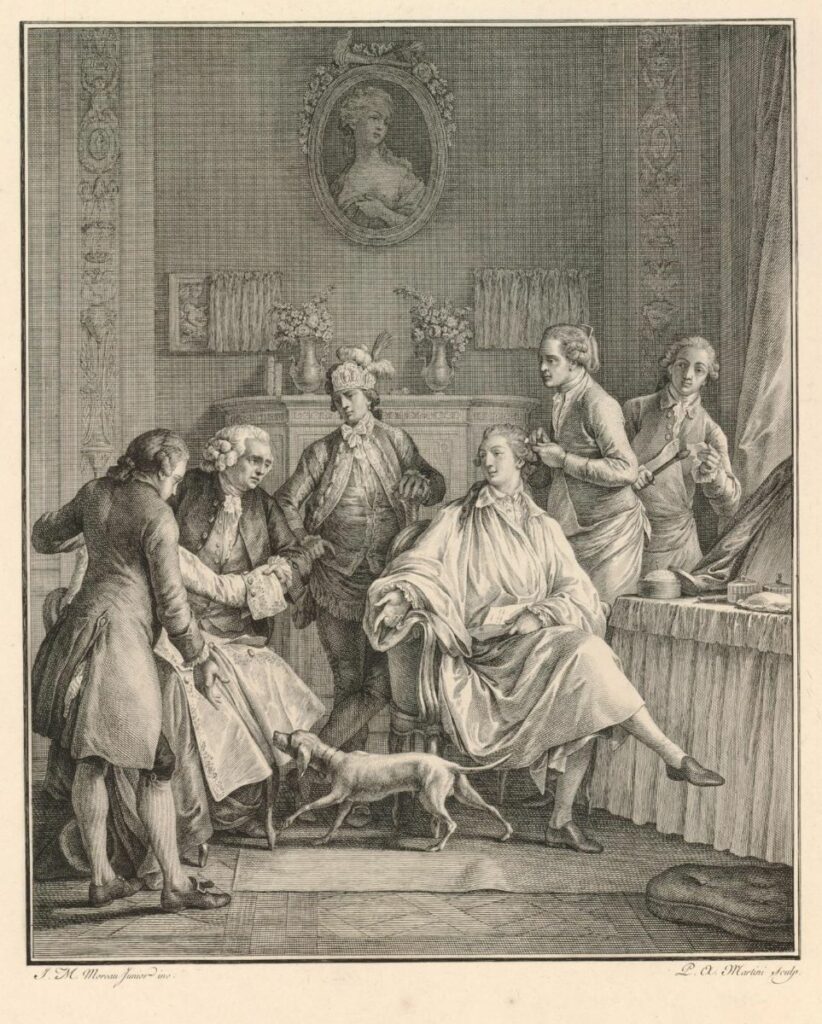
Effeminacy has been identified by historian Randolph Trumbach “as a distinctive characteristic of the modern homosexuality in the eighteenth century.” But as Jeffrey Merrick has noted, it is less clear that Trumbach’s model, developed in his foundational history of sodomitical culture and identity in England, applies as well to France.[36] In France, a sodomitical identity was only one of the possible valences of the fashionable efféminé. In many cases, the ambiguously gendered petit-maître was quite unambiguously heterosexual.[37] The point is underscored in Moreau le Jeune’s La Petite Toilette (1777) by the erotically charged paintings of women that adorn the walls of the petit-maître’s boudoir (Fig. 6). Even for Rousseau, who was concerned about the “epidemic of effeminacy,” the petit-maître was less a figure of non-normative sexuality than a symbol of the loss (or rejection) of traditional ideals of masculinity and virtue—a loss he attributed to too much social commerce between men and women.[38]
Over the course of the eighteenth century, so many authors penned novels, plays, and satires that focused on the petit-maître as frivolous, silly, and effeminate (and lovers of pink, of course), that it is easy to forget that in the salon petit-maître was a term of affection, as McNeil has pointed out.[39] It was used in a positive sense by the Earl of Charlemont, who declared in his admiring description of the elderly Baron de Montesquieu that, in the society of women, “the most accomplished, the most refined petit-maître of Paris could not have been more amusing . . . in that sort of discourse which is best suited to women, than this venerable philosopher of seventy years old.”[40]
The Earl met Montesquieu in Bordeaux, where the philosopher was a fixture in the salon of Madame Duplessy, the leading salonnière of that city. Montesquieu probably would not have minded the comparison of his manners to those of a refined petit-maître. In his own writing Montesquieu himself inclined towards “Mandevillian praise of the civilizing role of the petit-maître.”[41] Mandeville had vividly likened “the gaudy trimming and splendid equipage of a petit-maître, to the glistening brightness of the finest loaf sugar.”[42] For my purposes, that comparison between the petit-maître and refined sugar is as apt as it is witty, and the two shall meet again in due course.
The Charlemont passage is noteworthy on several other counts. Bordeaux had its own sparkling salon society, in which the refinements of the petit-maître were appreciated, much as they were in Paris.[43] With Montesquieu as one of its leading lights, Madame Duplessy’s salon was, like the Parisian salons, engaged in the project of Enlightenment. Socially her salon played the same kind of role as the salons in Paris. It was a space of the very sort of social commerce between men and women that was so worrying Rousseau and others. It was also a space where members of the bourgeoisie could acquire the manners and social skills of good society exemplified by the petit-maître-like refinement of Montesquieu.[44] Significantly, its attendees included would-be gentlemen such as the scion the Journu family, Olivier Journu’s eldest brother, Bonaventure.
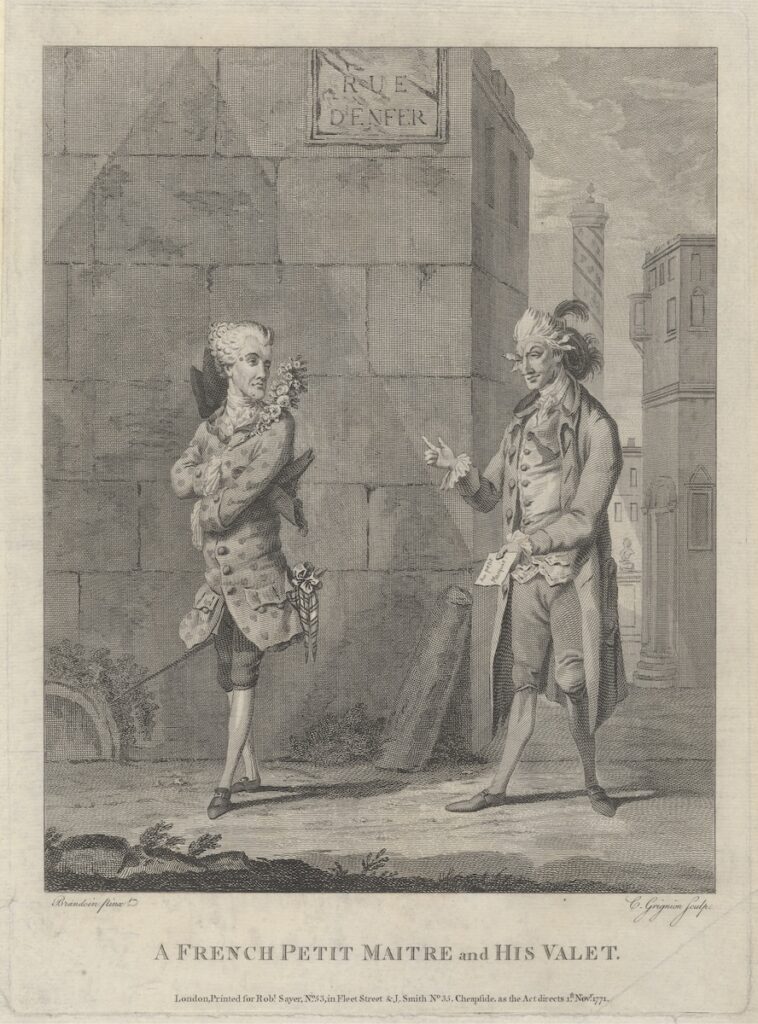
The petit-maître was the object of varying degrees of criticism and satire in French novels, plays, and philosophical discourse over the course of the century. Visual representations of the type in France appear earlier and tend to be more forbearing than what one sees in the plethora of negative caricatures of the macaroni in England. One example of the latter is of special interest here as it satirizes the French macaroni (Fig. 7). This print, A French Petit Maître and his Valet (1771), was published in England and produced by two London-based artists, the engraver Charles Grignion and Swiss illustrator Michel-Vincent Brandoin. The protagonist of their print sports a frock coat dotted with hearts, and ostentatiously displays all of the accoutrements of the type: the tricorn hat under his arm, the diminutive sword, beauty spots on his face. His bagwig, tied with an absurdly outsized bow, is matched in scale and extravagance by his corsage. This floral ornament protrudes above his shoulder and blocks his view as he turns, eyebrow cocked, with plummy disdain towards his valet, who brings him a letter inscribed “Au petit marquis.” Lacking the humor and silliness of other macaroni caricatures, this enigmatic print has been read by McNeil as one of many British images that identified the macaroni with sodomitical depravity.[45]
In contrast to such British prints, French representations are far fewer and tend not to be caricatural. They range from the gentle humor of Charles-Antoine Coypel’s Petit-Maître Pretending to Think (c. 1730) to the almost ethnographic neutrality of Moreau le Jeune’s petit-maître at his toilette—an image that nonetheless delights in the details of the dress and interiors of the fashionable man. Starting in the 1770s, the petit-maître was regularly featured in French fashion publications without any trace of ridicule.
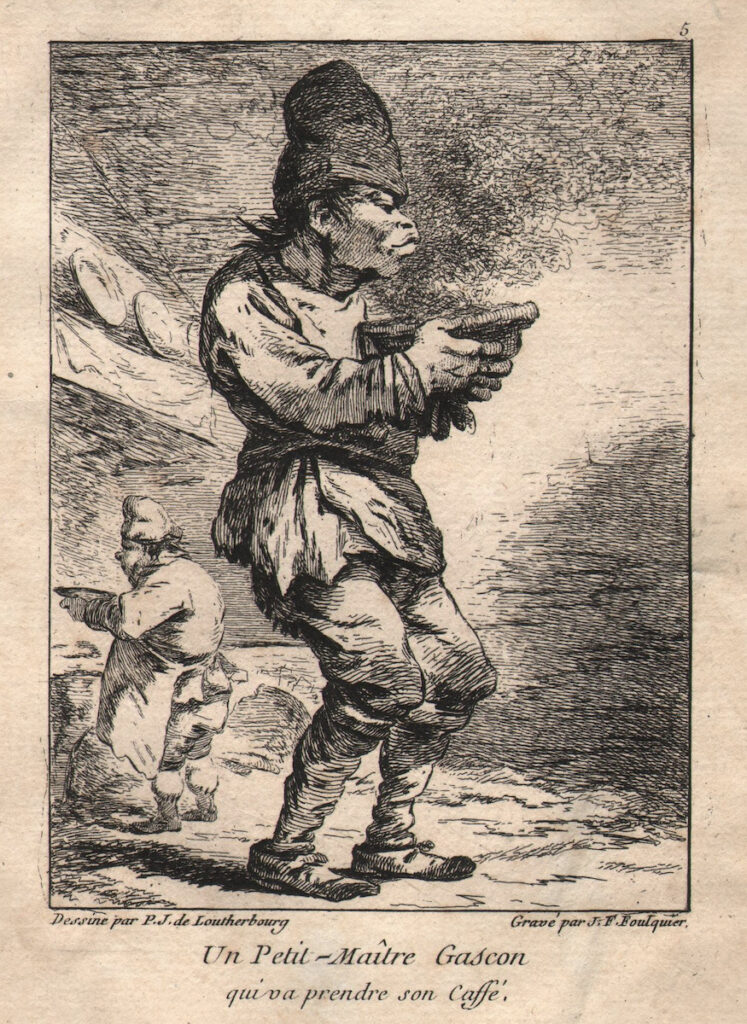
A notable exception to the general tendencies in French visual representations is Phillip James Loutherbourg’s caricature of (1771), which lampoons a brutish Gascon for his lack of refinement at least as much as it mocks the petit-maître for an excess of it (Fig. 8). By playing on cultural stereotypes about Gascon uncouthness and provinciality, Loutherbourg’s caricature suggests some of the issues that might have been at stake for the men of a socially ambitious Bordelais (Gascon) family such as the Journus, who were clearly anxious to make their good fortune visible, particularly in matters of dress, self-fashioning, etc. Loutherbourg’s oafish and grotesquely comical “Gascon Petit-Maître” begins to suggest why it would have been meaningful for the Journus to attend Duplessy’s salon, as Bonaventure certainly did.[46] Perhaps his brothers did too. It also offers insights into why it would have “suited” at least some of Journu men to dress in the latest Parisian fashions and to play the petit-maître (or at least to flirt with the type) in their pink dress suits.
In this context it is worth noting, too, that there is an anonymous copy of the Grignion print with a French caption added, which identifies the petit-maître as a “Little Gascon.” The regional identity given to this “French Petit-Maître” suggests the possibility of reading this print not only in terms of masculinity and sexuality, as McNeil has suggested, but also in terms of how these concerns can be inflected by hierarchies defined in terms of center and periphery.[47]
The Matter of Pink
The large number of portraits of men, women, and children in pink attest that it was a color favored by people of differing ages, classes, and genders.[48] As such, it was associated with expressions of various gender and class identities, but also with elegance, novelty, and aristocratic status or privilege. As I have already begun to suggest, pink could also be a matter of racial privilege. On the latter point, I am building on Wunsch’s essay on Boucher’s Portrait of Pompadour at her Toilette in which he makes the convincing case that, among other things, the emphasis on pink skin in Boucher’s portrait signaled white racial privilege (see Fig. 1).[49]
In the Fogg portrait, which shows Pompadour in “the act of constructing pink skin” (what Angela Rosenthal might have termed “the performance of whiteness”), is a function of the application of Pompadour’s rouge.[50] The colorants in rouge were often made from the same materials used to make reds in textiles. The most prized dyestuff for reds was carmine, which came largely from Spanish colonies in Latin America. Carmine was made from insects in the scale family, cochineal, which had been cultivated and used in Mexico since the early Mesoamericans. Beginning in the sixteenth century, it was produced for export by conquered Indigenous peoples.[51] In the eighteenth century another important source of red, brazilwood, was found in other European colonies, namely Brazil, for which the wood was named.
Like sugar and other luxury commodities, these sources of red produced by coerced or enslaved labor became much more widely available thanks to the expanding global consumer economy. Author and botanist Bernardin de Saint-Pierre lamented these ugly realities in 1773 when he wrote:
The lovely rose and flame colors in which our ladies dress, the cotton with which they trim their gowns, the sugar, coffee and chocolate for their breakfast, the rouge they use to set off their pallor, all this is prepared for them by the hands of wretched black people. Women of feeling, you weep at tragedies, yet those things which bring you pleasure are drenched with human tears and tainted with blood![52]
This passage highlights the colonial resonances in the “lovely rose colors” of women’s dresses, and in their rouge that was so often colored with carmine and brazilwood. Bernardin de Saint-Pierre had women in mind in calling out the human misery behind the “lovely rose colors” of their dresses, the pink on their cheeks, and the sugar in their coffee. But he could just have readily been addressing the Olivier Journus of his time, who also wore lovely rose colors and were known to wear rouge and consume sugar. In fact, the Journus were much more than consumers of sugar: their family fortune was at least partly founded on refining sugar—the most important product in colonial trade networks of the eighteenth century.[53]
Sugar and Spice and . . . L’Homme à la rose
The Portrait of Olivier Journu was one of a number of portraits that Perronneau made during several visits to Bordeaux between 1756-69 (see Fig. 2). Members of other prominent Bordelais families also sat for him, but the Journus were Perronneau’s most important clients.[54] The similarities in size and format of these portraits, the harmonious color schemes (which feature pink prominently), as well as the familial resemblances between the sitters suggest that the Journu portraits functioned as an ensemble. The portrait of Olivier, who died around 1764, was first in the series, and presumably thanks to its success, the others followed in quick succession—including at least two more portraits of Journu brothers in pink coats and waistcoats: the eldest, Bernard; Jean-Bernard, known as Le Hollandais; and possibly another unidentified brother.[55]
The portraits originally belonged to the matriarch of this prodigious clan of twelve sons and eight daughters. After Madame Journu’s death in 1771, the portraits passed to Bonaventure Journu, the new head of the family. Of the sons, Bonaventure was most enterprising and illustrious, and we know the most about him. He would become one of the richest négociants and armateurs in Bordeaux. Just before his death in 1781, he purchased the office of secretaire du roi in a provincial chancellerie (Dijon), an honorary office that conferred nobility upon himself and his heirs.[56] As I noted earlier, he was a denizen of Madame Duplessy’s salon, with whom he shared a passion for collecting objects of natural history. Bonaventure was also a collector of paintings, which were displayed, along with most of the Perronneau portraits, in his magnificent hôtel in the city’s toney area of the Cours du Chapeau-Rouge.[57]
Until the completion of this opulent mansion around 1778, Bonaventure had resided with his wife and most of his siblings in a lavish hôtel particulier their father had built in the heart of a thriving market quarter. This building in the rue de la Rousselle was also the locale of the spice and drug business that, along with trade in indigo and sugar, were the foundation of the considerable Journu family fortune. Close by, too, was the family’s sugar refinery.[58] Sugar, along with indigo, coffee, cocoa and cotton, was one of the key colonial commodities that circulated through eighteenth-century Bordeaux, which supplied these luxuries to the majority of Europe. Its port, known as the Port de la Lune, was one of France’s busiest.[59]
In the 1750s and ’60s, the Maison Journu was run by four of the brothers, including Olivier. At that time, the company was becoming involved in shipping and direct trade of colonial commodities with Saint Domingue. (These interests were advanced by marriage alliances between the Journu and Boyer-Fondrède family of négociants-armateurs.) Though not engaged directly in the Triangular Trade with Africa until the 1780s, the family’s tremendous wealth came from their involvement with a system of commerce that was intrinsically bound to the traffic in enslaved Africans and depended upon the products bonded labor.[60] The Perronneau portraits are implicated in these uncomfortable realities.
When Olivier sat for Perronneau, the Journus were still but “droguistes”—though “the greatest in their field,” according to the Swede Daniel-Zacharias Hallman, who visited the Journus’ impressive natural history cabinet in 1755.[61] Though the collection had then been but three years in the making, Hallman deemed it “the most perfect in Bordeaux.” It would figure in the 1757 edition of Dezallier d’Argenville’s Conchyliologie. These facts highlight how the timing of the Perronneau portraits contributed to the family’s displays of refinement and upward mobility, effected through the high society they frequented and their investments in the cultural capital of a marvelous cabinet de curiosité. Given the importance of shells in the lexicon of pinkness (and the semantic relationships between pink skin and racial whiteness), it is suggestive that portraits of Journu men in pink and the shell collection would appear under the same roof. Their shells, like their sugar, came from their colonial trade networks. At a minimum, both forms of cultural activity were a sign of the family’s ever-increasing participation and success in a culture of refinement.
Here I am evoking “refinement” in the sense, both symbolic and real, taken up by Kay Dian Kriz in her groundbreaking book Slavery, Sugar, and the Culture of Refinement. Refinement, of course, refers to the processes by which sugar is produced, but in Kriz’s book it is also a metaphor for forms of refinement that went beyond the cultivation, extraction, and purification of Caribbean sugar cane. Refinement applied to people (especially those in the West Indies, far from the metropole), “who could be assessed in terms of their rudeness or refinement,” and who could undergo a process of refinement themselves.[62] In this regard, Mandeville’s comparison of the petit-maître to “a refined sugar loaf” seems prescient. The metaphor of “refinement” is also a constant reminder of the sugar/slavery nexus.[63]
I suggest that much of Kriz’s account applies to the culture of refinement in the French imaginary as well. For social climbers like the Journus, “refinement” is an apt metaphor for their ambitions, which were grounded in the literal whiteness of sugar. How fitting it was that at the same time the Journus were the process of refining themselves—transforming themselves from “rude” provincials and non-nobles into aristocratic gentlefolk—that the Maison Journu were also sugar refiners, whose business it was to transform raw (brown) sugar into the whitest sugar possible, the finest grade being “sucre-royal.” As Joseph Gilliers noted in his famous confectionery dictionary of 1751, “The more one refines sugar, the whiter it is until it becomes sucre-royal.”[64] It is virtually impossible to read such lines without thinking in anthropomorphic terms of race and class. For the Journus, just as the process of purifying and refining sugar yielded sugar of the most perfect whiteness, their own refinement led to their eventual ennoblement and more perfect racial whiteness—in the Perronneau portraits, as in many others, signified by pink.
The Journus’ social aspirations are articulated in Perronneau’s portraits through the luxury and fashionable elegance of dress, in which pink figures so notably. Pink, I have argued, is particularly associated with the culture of refinement (socially and racially), in part—for the Journu men at least—through the figure of the petit-maître. The portraits of Olivier, Jean-Baptiste (Le Hollandais), and Bernard, all painted around the same time, display many of the defining characteristics of the petit-maître. In addition to the pink habit, there is the fine lace and the bagwig, worn en solitaire, the latest fashion at the time. Dominique Arnoult has noted that the solitaire served to highlight the whiteness of a sitter’s linen.[65] It also heightens the contrast with the pallor of a man’s skin, much as dark-skinned attendants or heavy rouge did for women. Le Hollandais holds a small tricorn under his arm. The hollow in the fabric under Olivier’s left arm may suggest the imprint of a tricorn he no longer carries.[66] All three brothers evoke the refinements of the petit-maître in their dress. Lacking Olivier’s insouciance and elegance, however, Le Hollandais and Bernard do not present the pleasing affect of a petit-maître, as Olivier does. Nor do they have his conspicuous, proto-macaroni nosegay, to which I will return.
Olivier’s especially effective embodiment of the “culture of refinement” (with all that that entails) is particularly visible when one compares his portrait to the sobriety and simplicity of a portrait Perronneau made of another sitter, also in Bordeaux around the same time.[67] Identified as François Gorsse, member of an elite ecclesiastical family of viticulturalists in the region, this man is at least as handsome as Olivier Journu and of the same age. But Gorsse, dressed in a simple gray velvet suit, with a modest flourish of bobbin lace on his linen shirt, has nothing of the Journu ostentation. His forthright, frontal pose eschews any of Olivier’s sinuous nonchalance. The almost monochromatic color scheme is understated and suggestive of moral rectitude, and perhaps a tinge of melancholy.
The portrait of Olivier Journu is both fetching and seductive and vividly captures a sense of the sitter’s confident self-possession, and yes: refinement. With the gracefully asymmetrical staging of his body, as he leans on the unseen arm of his chair, his demeanor is once alert and deliberately languorous. His head, ever so slightly cocked to the right, suggests an attitude of listening, of sociable engagement with the viewer and a reciprocal invitation to engage. But the elements of the portrait that most insistently represent Journu’s refinement (and his “feminine” masculinity) are the roses and the magnificent coat.
The rose boutonnière is remarkable both for its visual prominence and for its singularity in French portraits of men. Though such nosegays would later be a standard accoutrement of the macaroni, in France the flower had more exclusive associations with femininity. (Its possible meanings are multivalent: does it function here as an emblem of sexual conquest or of non-normative masculinity? Or both?) The peachy-pink luster of the roses also rhymes evocatively with Journu’s fair, glowing skin.[68] Perronneau creates a visual affinity between them that invites direct comparison between the sitter’s “white” complexion and the flower that gave pink its name. In echoing the tones of the sitter’s face, the boutonnière does some of the work of constructing pink skin achieved in Boucher’s Portrait of Pompadour at her Toilette through its representation of the application of cosmetics.
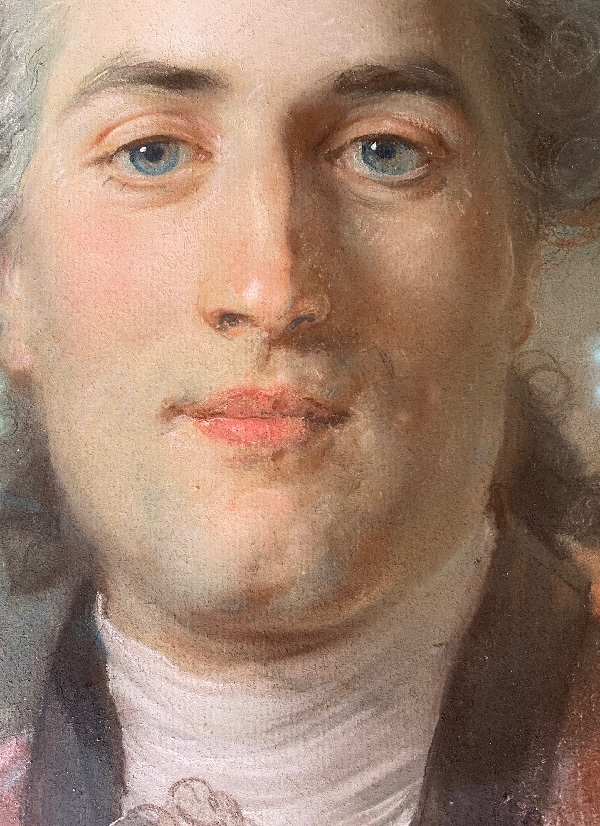
Journu lacks any artificial coloring on his cheeks, though his lips are sensuously heightened with a surprisingly vivid reddish pink (Fig. 9). Here the blushing pinks that heighten Pompadour’s white skin coloring are to be found instead in the vaporously, dusky pink red of Journu’s velvet suit—a suit that Perronneau’s first biographers aptly described as the main character in the portrait.[69] Its coloring calls to mind the semantic associations between couleur de rose/chair/incarnat and “white” (pink) skin. Indeed, the suit itself might be said to operate here as a second skin, in which Journu seems as comfortable and confidently insouciant as he clearly is in his first.[70] While, in a sense, all clothing can be understood as an extension of the body that acts as a second skin, Journu’s second skin is something more. Because of its color and because of who he was, it carries with it all of the possible meanings of pink: it is part of a performance of whiteness, itself involved in the pigmentary constitution of race, which is also associated with the aspirational ideal of (white) refinement emblematized by the petit-maître and all his ambiguities.
La Vie en Rose
Wunsch has argued that the performative dimensions of Boucher’s Portrait of Pompadour at her Toilette go beyond a performance of identity, female autonomy, and social mobility to include a performance of whiteness; and further that Pompadour’s personal connections to and knowledge of the French slave trade informed how she “used art to play with the status and privilege afforded by her complexion.”[71] For the Journus, their connections to the institution of slavery were more direct and present in the business of their daily lives, but no less manifest in (at least some) of the portraits they commissioned from Perronneau—portraits in which pink, refinement, and the privileges afforded by the sitters’ complexions were displayed. The portraits themselves were displayed in a spectacular mansion that stood for the family’s social ascent; an edifice that overflowed with luxuries, including the cabinet de curiosité with the wondrous collection of shells obtained from the captains of ships the Journus outfitted for voyages to the West Indies. One visitor noted the numerous tables surmounted by white figurines of Sèvres biscuit, a medium invented to replace centerpieces made of the sugar that helped to make the Journus.[72] The ground floor was a storehouse for the raw sugar and other goods and materials that circulated as part of the global economy of the slave trade.[73] All were clear and present reminders of the sugar/slavery nexus that attended the culture of refinement and the status and privileges afforded by whiteness and “la vie en rose.”
Melissa Hyde is Professor of Art History and Distinguished Teaching Scholar at the University of Florida
Acknowledgments: My thanks to Ewa Lajer-Burcharth, Catherine Girard, Thea Goldring, Meredith Martin, and Hannah Williams for their encouragement, excellent suggestions, and insights, as well as to the anonymous readers. I have been fortunate to receive indispensable feedback also from many other friends and colleagues, to whom I owe a debt of gratitude: Oliver Wunsch, Jennifer Germann, Anne Lafont, and Mechthild Fend, who first invited me to present on the color pink at Goëthe-Univeristät in Frankfurt; to Magnus Olausson for the invitation to present material at a Tessin Lecture at the Nationalmuseum, Stockholm; and to Eik Kahng for a subsequent invitation to present at the Santa Barbara Museum of Art. A special thanks to David Pullins who arranged for me to consult the curatorial files on the Portrait of Olivier Journu at the Met, and in whose company I had the pleasure to look closely at the portrait. And, finally, my thanks to Eric Segal, for his careful reading of my drafts. And for everything else. Always.
[1] Michel Pastoureau, Red: The History of a Color, trans. Jody Gladding (Princeton: Princeton University Press, 2017), 148.
[2] The focus of Madame de Pompadour: Painted Pink, ed. Cassandra Albinson (New Haven: Yale University Press, 2022). For earlier discussions see, among others: Melissa Hyde, “The ‘Makeup’ of the Marquise: Boucher’s Portrait of Pompadour at the Toilette,” The Art Bulletin 82, no. 3 (2000): 453-75; and Ewa Lajer-Burcharth, “Pompadour’s Touch: Difference in Representation,” Representations 73, no. 1 (2001): 54–88.
[3] Melissa Hyde, Making Up the Rococo: François Boucher and his Critics (Los Angeles: Getty Research Institute, 2006).
[4] Important recent work on France includes studies by Anne Lafont, Mechthild Fend, Meredith Martin and Gillian Weiss.
[5] Oliver Wunsch, “Making Up Race: Whiteness, Pinkness and Pompadour,” in Albinson, Painted Pink, 78.
[6] Pictured in Neil Jeffares, “Perronneau,” Dictionary of pastellists before 1800, online edition, http://www.pastellists.com/articles/Perronneau1a.pdf (all web links accessed March 25, 2024).
[7] Léandre Vaillat and Paul Ratouis de Limay, J-B. Perronneau (1715–1783) (Paris: Frédéric Gittler, 1909), 32.
[8] Albanne Forestier, “La figure du petit-maître est-elle subversive?” Apparence(s) Histoire et culture du paraître 12 (2022), https://journals.openedition.org/apparences/4225
[9] See Kevin Bideaux, “Is white skin really pink? Flesh color as a pink color in Western art and culture,” Color Culture and Science Journal, 13, no. 2 (2021): 42-9, https://hal.science/hal-03445903/document; Anne Lafont, “How Skin Color Became a Racial Marker: Art Historical Perspectives on Race,” Eighteenth-Century Studies 51, no. 1 (2017): 106.
[10] As in the taffeta suit worn by the hero in Madame D’Aulnoy’s fairy tale “Le Rameau d’or,” Cabinet des fees (1697) 2:282, or Crébillon’s fils’ famous pink Sopha (1742). On Crébillon, see Rory Bloom, “Un Sopha rose brodé d’argent: Crébillon fils and the Rococo,” The Eighteenth Century 51, no. 1–2 (2010): 87–102. See Aurélia Gaillard, “Le rose des Lumières. (Identités visuelle, sociale et sexuée du rose),” Lumières (2020): 31–64.
[11] “Rose,” Dictionnaire universel François et latin, 5 vols. (Paris: Gondouin, 1732) 4:1627.
[12] “Rose” (Botan.), Encyclopédie, ou dictionnaire raisonné des sciences, des arts et des métiers, etc., eds. Denis Diderot and Jean le Rond d’Alembert. University of Chicago: ARTFL Encyclopédie Project (Autumn 2022 Edition), Robert Morrissey and Glenn Roe (eds.), http://encyclopedie.uchicago.edu/.
[13] Boucher himself was an avid collector of shells. See Jessica Priebe, François Boucher and the Art of Collecting in Eighteenth-Century France (Abingdon, Oxon: Routledge, 2023).
[14] Mark Ledbury, “‘Many Truths of Nature and a Rich, Flowing Brush,’ Boucher, Pink and the Culture of Natural History,” in Albinson, Painted Pink, 52-3. On the procurement of shells through the labor of Black bodies, see Marisa Anne Bass, Anne Goldgar, Hanneke Grootenboer, and Claudia Swan, Conchophilia: Shells, Art, and Curiosity in Early Modern Europe (Princeton: Princeton University Press, 2021).
[15] “Incarnat,” Dictionnaire universel française et latin vulgairement appelé Dictionnaire de Trévoux (Paris: Compagnie des libraires associés, 1771) 5: 113.
[16] Pastoureau, Red, 148.
[17] Anonymous [Dezallier d’Argenville], Conchology, or Natural history of shells (London: T. Jones, 1771), 23.
[18] Richard Dyer, “White,” Screen 29, no. 4 (1988): 46.
[19] See Angela Rosenthal, “Visceral Culture: Blushing and the Legibility of Whiteness in Eighteenth-Century British Portraiture,” Art History 27, no. 4 (2004): 563-92; and, more recently, Mechthild Fend, Fleshing Out Surfaces: Skin in French Art and Medicine 1650–1850 (Manchester: Manchester University Press, 2017).
[20] Antoine Le Camus, Abdeker, or the Art of Preserving Beauty (London, 1754).
[21] See, for example, Rosenthal, “Visceral Culture,” 568-69; and Lafont, “Skin Color,” 91-3.
[22] Lafont, “Skin Color,” 104, 106.
[23] Richard J. Campbell, “The Sacrifice of the Rose by Jean-Honoré Fragonard: A Late 18th-Century Inflection of a Traditional Erotic Symbol,” The Minneapolis Institute of Arts Bulletin 66 (1983): 18–47.
[24] Pierre Guiraud, Dictionnaire érotique (Paris: Payot, 1978), 247.
[25] Denis Diderot, Salon de 1759, in Essais sur la peinture, Salons de 1759, 1761, 1763, éd. Jacques Chouillet (Paris: Hermann, 1984), 102.
[26] See LaPeyre, Les Moeurs de Paris (Amsterdam, 1747), 75. Jean-Baptiste Pierre quoted in Christian Michel, Charles-Nicolas Cochin et l’art des Lumières (Rome: Ecole Française de Rome, 1993), 631.
[27] It is clear that men did actually wear pink fashions. For one example, see Valerie Steele, Pink: The History of a Punk, Pretty, Powerful Color (New York: Thames and Hudson, 2018), 20.
[28] One thinks of the one in Anne Vallayer-Coster’s Still Life with Shells and Corals (1769) at the Louvre, https://www.wga.hu/frames-e.html?/html/v/vallayer/stillife.html.
[29] L. Roger-Milès, Cent Pastels (Paris: Georges Petit, 1908), 87.
[30] Encyclopédie, 9. On the petit-maître, see Karen J. Manna, “Sex, Politics, and National Identity: The Petit-Maître in Eighteenth-Century France” (PhD dissertation, Johns Hopkins University, 2013). See also Pierre Saint-Amand, “Le triomphe des Beaux: petits-maîtres et jolis hommes au dix-huitième siècle,” L’Esprit Créateur 43, no. 3 (2003): 37–46; Forrestier, “La figure du petit-maître.”
[31] Peter McNeil, Pretty Gentlemen: Macaroni Men and the Eighteenth-Century Fashion World (New Haven: Yale University Press, 2018).
[32] In that regard the macaroni may be usefully compared to the extravagantly fashionable muscadins of later eighteenth-century France, who similarly issued from social unrest of war and Revolution and who, like the petit-maitres phenomenon, were also subversive of sartorial gender norms. See Ewa Lajer Burcharth, Necklines: The Art of Jacques-Louis Davis After the Terror (New Haven: Yale University Press, 1999), especially chapter 3, section 6, “Directorial Self-Fashioning,” 181–204.
[33] Discussed in Jörg Eberling, “Tableaux de mode: Studien zum aristokratischen Genrebild in Frankreich in der ersten Hälfte des 18 Jarhunderts” (PhD dissertation, Philipps-Universität, Marburg, 2012). On Moreau le Jeune, see Bernardine Heller-Greenman, “Moreau le Jeune and the Monument du Costume,” Athanor 20 (2002): 69–70.
[34] McNeil, Pretty Gentlemen, 14–16.
[35] François-Charles Gaudet, La Bibliothèque des petits-maîtres (Paris, 1741), 185.
[36] Jeffrey Merrick, “Patterns and Concepts in the Sodomitical Subculture of 18th-Century Paris,” Journal of Social History 50, no. 2 (2016): 290.
[37] McNeil, Pretty Gentlemen, 34
[38] Manna, Sex, Politics and National Identity, 97–101; Forestier, “Figure du petit-maître.” See also Jean-Jacques Rousseau, Narcisse ou L’Amant de lui-même, Théâtre Classique, eds. Gwénola, Ernest et Paul Fièvre (February 2015), 35, http://www.theatre-classique.fr/pages/pdf/ROUSSEAU_NARCISSE.pdf.
[39] McNeil, Pretty Gentlemen, 98.
[40] James Caufield, Memoirs of the Political and Private Life of James Caufield, Earl of Charlemont, ed. Francis Hardy (London, 1812) 1: 68–69.
[41] Elena Russo, “Virtuous Economies. Modernity and Noble Expenditure from Montesquieu to Caillois,” Historical Reflections/Réflexions Historiques 25, no. 2 (Summer 1999): 76.
[42] Bernard Mandeville, La Fable des abeilles (London,1740) 1:108.
[43] See André Grellet-Dumazeau, La Société bordelaise sous Louis XV et le salon de Mme Duplessy (Bordeaux, 1897).
[44] Christine Adams, A Taste for Comfort and Status: A Bourgeois Family in Eighteenth-Century France (Philadelphia: Penn State University Press, 2000).
[45] McNeil notes the rue d’Enfer street sign and the suggestion of “a ‘cock and balls’ leaning against the wall in the centre; the drain or sewer to the left connotes the back-passage.” McNeil, Pretty Gentlemen, 175.
[46] Grellet-Dumazeau, Société bordelaise, 248.
[47] The print is reproduced in Grosvenor Print Catalogue 129, Summer Solstice 2023; item #114, https://aba.org.uk/assets/catalogues/[email protected]/Grosvenor-Prints-Catatalogue-129.pdf.
[48] These portraits are too many to enumerate here, but a good selection is to be found in Jeffares, “Perronneau,” http://www.pastellists.com/articles/Perronneau1a.pdf.
[49] Wunsch, “Making Up Race,” 74–85.
[50] Wunsch, “Making Up Race;” Rosenthal, “Visceral Culture,” 578.
[51] Elena Phipps, Cochineal Red: The Art History of a Color (New York: Metropolitan Museum of Art, 2010).
[52] Jacques-Henri Bernardin de Saint-Pierre, Voyage à l’Isle de France, à l’Isle de Bourbon, au Cap de Bonne-Espérance (Amsterdam, 1773) 1:204.
[53] Though I do not have the space to discuss it here, artists’ pigments were also products of this global economy; such material origins also inflect the meanings of works made possible by invisible forced labor. See Georges Roque, La cochenille, de la teinture à la peinture. Une histoire matérielle de la couleur (Paris: Gallimard, 2017).
[54] Jeffares, “Two Pastels of the Journu Family by Perronneau,” http://www.pastellists.com/Essays/Perronneau_Journu.pdf.
[55] Dominique Arnoult identifies the sitter of a fourth portrait of a man in pink from 1757 as a member of the Journu family or of one of the families with whom they were allied through marriage. In 1757, one Journu sister, Angélique (Mme Molles), was portrayed in gray and pink. Some ten years later, more “pink” portraits were added to the ensemble: those of Marie Angélique Boyer-Fronfrède (née Journu) and her husband, Pierre. Dominique Arnoult, Jean-Baptiste Perronneau (Paris: Arthena, 2014), 259; and Jeffares, “Perronneau,” Dictionary of pastellists, http://www.pastellists.com/articles/Perronneau1a.pdf.
[56] Perrin Stein, The Wrightsman Pictures (New York: Metropolitan Museum of Art, 2005), 180. Jeffares, “Two Pastels of the Journu Family by Perronneau,” http://www.pastellists.com/Essays/Perronneau_Journu.pdf.
[57] Jeffares, “Two pastels of the Journu family by Perronneau,” 3.
[58] Maurice Meaudre de Lapouyade, “Perronneau,” Le port des Lumières. La peinture à Bordeaux 1750–1800 (Bordeaux: Musée des Beaux-Arts et William Blake and Co, 1989) 1:78. See also Paul Butel, Les dynasties bordelaises de Colbert à Chaban (Paris: Perrin, 1991), 145-57.
[59] If until the 1780s Bordeaux played a smaller role in the Atlantic slave trade than other ports négrier, the products of bonded labor were everywhere in evidence in the city, even if that coerced labor itself was largely invisible.
[60] In 1773 the sugar refining business was sold, and Bonaventure Journu & Cie would go on to become one of the most successful armateurs in Bordeaux, outfitting ships bound for the West Indies and the Antilles. By the end of the century, Journu frères owned six ships of up to 750 tons that operated slave and sugar trading from the port of Bordeaux. Romauld Szramkiewicz, Les régents et censeurs de la Banque de France (Genève: Librarie Droz, 1974), 201.
[61] Hallman credited the Journu cabinet to two of the brothers without naming them. Presumably one of them was Bonaventure. Paul Courteault, “Bordeaux au temps de Tourny,” Revue historique de Bordeaux 9 (1916): 145. In 1769 Bonaventure had Perronneau paint his portrait posed before specimens from the celebrated cabinet.
[62] Kay Dian Kriz, Slavery, Sugar, and the Culture of Refinement: Picturing the British West Indies, 1700–1840 (New Haven: Yale University Press, 2008), 4.
[63] Beth Fowkes Tobin, “Review of Slavery, Sugar, and the Culture of Refinement,” Slavery and Abolition 31, no. 1 (2010): 139. For related discussion, see Simon Gikandi, Slavery and the Culture of Taste (Princeton: Princeton University Press, 2011) http://www.jstor.org/stable/j.ctt7svr8.
[64] Joseph Gilliers, Le Cannameliste française (Nancy, 1751), 226.
[65] Arnoult, Perronneau, 258.
[66] Arnoult, Perronneau, 257.
[67] Jeffares, “Perronneau” http://www.pastellists.com/Articles/Perronneau1.pdf.
[68] Conservation reports in the Met’s curatorial files suggest that the roses may have been colored with carmine, which has faded, meaning that the roses may originally have been even more pink.
[69] Vaillat and Ratouis de Limay, Perronneau, 32.
[70] On this subject, the classic source is Marilyn J. Horn and Lois M. Gurel, The Second Skin: An Interdisciplinary Study of Clothing (Boston: Houghton Mifflin, 1981).
[71] Wunsch, “Making Up Race,” 75.
[72] Alicia Caticha is currently writing a much-anticipated book on Sèvres biscuit and other materials entitled Sculpting Whiteness: Marble, Porcelain, and Sugar in Eighteenth-Century Paris.
[73] An inventory of the Hôtel Journu made during the revolution recorded, for example, “une grande marmite pour la traite des noirs.” Oudot de Dainville, “L’intéreiur d’un négociant bordelais au XVIIIe siècle,” Revue philomatique de Bordeaux et du sud-ouest 22 (1919): 220–22.
Cite this article as: Melissa Hyde, “Men in Pink: The Petit-Maître, Refined Masculinity, and Whiteness,” Journal18, Issue 17 Color (Spring 2024), https://www.journal18.org/7284.
Licence: CC BY-NC
Journal18 is published under a Creative Commons CC BY-NC International 4.0 license. Use of any content published in Journal18 must be for non-commercial purposes and appropriate credit must be given to the author of the content. Details for appropriate citation appear above.
